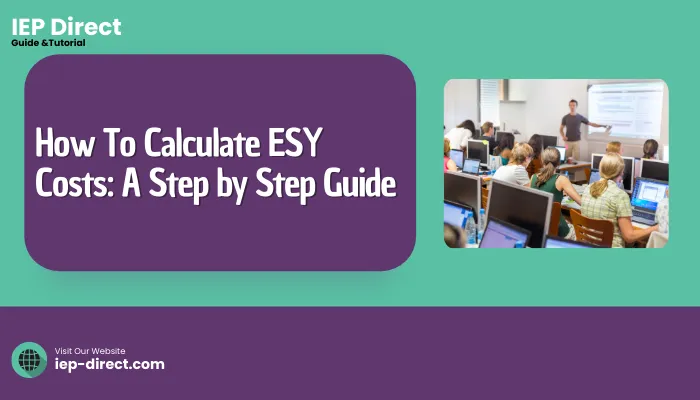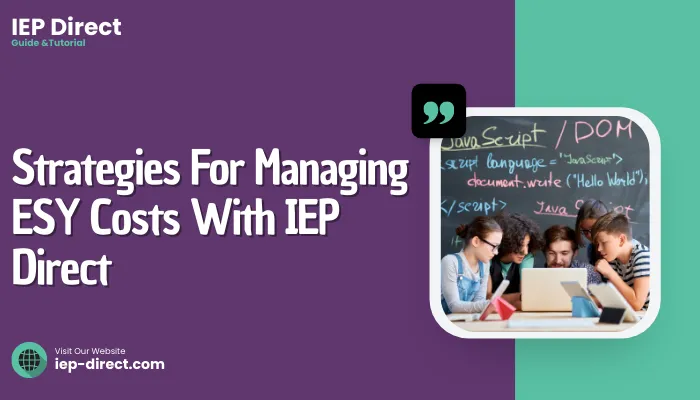Hi there! I’m Ava Jones IEP Direct pricing expert , and I help schools in budgeting for Extended School Year (ESY) services. In this guide, we are going to discuss what can be used to calculate these costs.

It is rather simple in its structure, and I will do my best to make you understand easily.

IEP Direct Pricing: Getting To Know ESY
IEP Direct pricing is covered under Extended School Year (ESY) services, offer extra help to students who need it based on their Individualized Education Programs (IEP). These services are usually available during summer or other breaks when regular classes aren’t in session.
Why Is the Extended School Year (ESY) So Important?
Understanding IEP Direct pricing helps explain why Extended School Year (ESY) is crucial. It prevents skill loss and supports continuous learning for students, especially those with changing educational needs.
- Learning skills: Being acquired are reinforced. Students will retain the skills learned during the school year and nonangling students will keep hitting the books.
- Skill level decline: Will be avoided. In the absence of practice or skills reinforcement like practices during school holidays or in breaks, students will typically regress and lose the skills they have learned.
- IEP’s desires: Are sometimes learners changes. Some basic educational skills left out in the IEP direct pricing can be supplied in an ESY.
With Frontline IEP Direct pricing, ESY becomes a vital tool. It ensures skills are maintained and helps students achieve their educational goals during school breaks.
What Are the Common Features of ESY Programs?
ESY services can be different for each student. They often include extra teaching, therapy, and support based on what each student needs. Knowing IEP Direct pricing helps get the right help.
- Instruction in Academics: Covers subjects like reading, writing, math, science, and includes language, speech, and physical therapy.
- Recreational Language Sessions: Enhance speech skills.
- Restoration of Functional Mobility: Focus on body movements and walking.
- Stress Regulation Therapy: Offers psychological and social support.
- Travel Services: Ensure safe trips to and from ESY programs.
- Emotional Management: Helps students with behavioral challenges.
ESY services offer extra help like teaching and therapy. Knowing IEP Direct pricing ensures students get the right support.
How Is ESY Decided for Each Student?
A student with an IEP is the only one who qualifies for ESY, based on the recommendations of the student’s IEP team.
The team assesses the following aspects:
- Severity of the disability: ESY is more likely for students with severe disabilities.
- Risk of Regression: Students at high risk of losing skills during school breaks may qualify for ESY.
- Individualized Needs: The IEP team determines if ESY services will meet the student’s needs effectively.
ESY is crucial for students with disabilities as it supports their continued progress. Knowing IEP Direct pricing ensures they receive the appropriate help.
Breaking Down IEP Direct Pricing
IEP Direct pricing is a full-fledged system controlling the Extended School Year (ESY) activities of the educational institution.
It offers an easy-to-use interface that simplifies all the complicated tasks related to ESY, from budgeting and planning to monitoring and evaluating students’ progress.
How Does IEP Direct Pricing Actually Work?
So it is possible that IEP Direct may come up with different pricing structures to meet the needs of your school or district. Still, such fundamental prices range normally has the following elements:
- Base Fee: This is a constitutive monthly or yearly payment required by the settled users for constituting the general functionalities of the system.
- User Licenses: Individual users who will be accessing the platform may have to be purchased their own user licenses by schools.
- Additional Modules: IEP Direct in addition may also provide extra modules for school clients who have more elaborate ESY programs, and such modules are purchasable separately.
Therefore, IEP Direct pricing varies by needs, including base fees, user licenses, and additional modules. Understanding these costs ensures tailored support for schools.
How IEP Direct Helps with ESY Progress Monitoring
IEP Direct has capabilities that if incorporated into the processes of any ESY program can lead to increased efficiency and effectiveness of the ones already in existence. Examples of such improvements include:
- Centralized Data Storage: All information related to ESY, including student data, service plans, attendance, and progress/summary reports, is maintained in a secure and well-organized central system.
- Less Complicated Budgeting and Planning: The tools for budgeting available on the system would enable the schools to come up with efficient and reasonable estimates for the ESY program, in addition to that the features for planning would help in the organization of the provision of services and the arrangement of resources.
- Improved Communication: IEP Direct has the capability to enhance communication within school personnel, parents, and service providers, all directing their efforts toward the same target.
To summarize, schools seeking to reform their Extended School Year (ESY) processes for enhancing student results can look at IEP Direct as a powerful device.

How To Calculate ESY Costs: A Step by Step Guide
Proper budgeting is crucial for Extended School Year (ESY) services, as schools need to ensure they adequately budget for eligible students’ support.
Understanding IEP Direct pricing and Frontline IEP Direct pricing is essential for accurate financial planning.
Steps for budgeting include calculating the cost to provide pertinent ESY-related services.
How the Cost Formula for ESY Works
The costs incurred for ESY services will likely be determined using the base formula with the following elements. Understanding IEP Direct pricing and Frontline IEP Direct pricing is key to this calculation.
- Service Hours: This is the total number of ESY service hours that a student is estimated to receive in return.
- Staff Salaries: What is the hourly rate of the personnel who shall be providing the ESY services.
- Material Costs: Outlays incurred in the purchase of certain materials necessary in the provision of the challenged zone services, like textbooks, worksheets, or additional paraphernalia.
- Indirect Costs: Overhead expenses like utilities, rent, and administrative expenses are part of these costs.
| The Basic Formula | Details |
|---|---|
| Service Hours | The total hours of ESY services provided. |
| Staff Salaries | The salaries paid to staff members involved in providing ESY services. |
| Material Costs | The costs of materials required for ESY services. |
| Indirect Costs | Any additional indirect costs associated with ESY services. |
| ESY Cost | (Service Hours * Staff Salaries) + Material Costs + Indirect Costs |
Understanding the basic formula for calculating ESY costs helps schools budget effectively, ensuring they allocate resources appropriately for ESY services. This formula provides a clear framework for financial planning.
What Affects the Cost of ESY Services?
The changes made to ESY services and the resulting costs are dependent on the following factors:
- Intensity of Services: More intensive ESY services are required for students with severe disabilities, thus increasing costs. Understanding IEP Direct pricing is essential here.
- Type of Services: The nature of the specific ESY services provided can also determine the costs incurred. Frontline IEP Direct pricing can help in budgeting for these services.
- Staff Qualifications: The qualifications and experience of the staff providing ESY services play a role in determining salary rates and cost outlines.
- Location: The physical location can also affect the costs of ESY due to varying levels of salaries, material costs, and overhead.
| Example Calculation | Details |
|---|---|
| Service Hours | 20 hours per week for 10 weeks |
| Staff Salaries | $25 hourly wage |
| Material Costs | $500 |
| Indirect Costs | $1,000 |
| Formula | ESY Cost = (20 hours/week x 10 weeks x $25/hour) + $500 + $1,000 |
| Calculation | ESY Cost = $5,000 + $500 + $1,000 |
| Total ESY Cost | $6,500 |
Therefore, by knowing how to compute ESY costs and the factors involved, schools can create accurate budgets and ensure students get the support they need to succeed.
A Look at Frontline IEP Direct Pricing
As a way of enhancing effective management of Individualized Education Programs (IEP) and Extended School Year (ESY) services, Frontline IEP Direct is an effective software solution that is gaining popularity among the administrators.
Its pricing model has been structured in such a way that caters to the different needs of different school districts and organizations.
Everything You Need to Know About Frontline IEP Direct Pricing
Usually, Frontline IEP Direct follows a tiered pricing methodology, which implies that the cost of the software varies with the number of users and the features included in it.
Common pricing components may include:
- Base License Fee: This is a standard or a set amount provided by the customer in return for the company’s basic access to the software.
- User Licenses: Some additional funds may be used to acquire some user licenses for each staff using the software that has been acquired by the school.
- Module Fees: More advanced schools may contact Frontline IEP Direct and inquire about the extra modules that are sold separately like special education modules, student information system modules or attendance tracking modules.
- Implementation and Training Costs: These costs are either incorporated in the overall pricing package or they are charged on their own.
How Does Frontline IEP Direct Compare to Other Platforms?
Frontline IEP Direct’s price may differ as compared to other existing similar platforms.
The reasons for such differences in pricing may be the following:
- Features and Functionality: It is obvious that platforms that comprise more advanced features or have more capabilities, will cost higher.
- Scalability: Platforms that aim at larger systems like bigger school districts or big organizations differ in pricing models from the ones that aim at the smaller institutions.
- Customer Support: Prices can also be influenced by the amount of customer support that the platform will offer.
How Frontline’s Pricing Affects ESY Costs
Although Frontline IEP Direct system is not designed in any way to enhance the calculation of ESY costs, it is apparent that this system can lead to a number of effects which will affect the calculations.
The following reasons are:
- Improved Efficiency: The management of ESY services can be enhanced by the application of Frontline IEP Direct leading to less administrative costs and better resource management in schools.
- Enhanced Data Management: The software’s capacity for monitoring the performance, attendance and services given to individual students would therefore enable informed decisions concerning ESY programming and budgeting.
- Compliance Support: According to the regulation concerning Extended School Year (ESY), a school should demonstrate compliance with both federal and state controls and these can be achieved with the aid of the Frontline IEP Direct.
To sum up, IEP Direct offers a solid approach for IEPs and ESY management. Understanding Frontline IEP Direct pricing helps schools assess if the investment is worthwhile for ESY programs.

Strategies For Managing ESY Costs With IEP Direct
Extended School Year (ESY) services has been or could be a drain of funds in schools. However if cost is controlled well, schools can guarantee that they will not be cleansing but rather providing services that are of high standard at an affordable cost.
How to Use IEP Direct for Better Cost Management
IEP Direct offers valuable tools for managing ESY costs effectively. By leveraging data-driven insights, streamlining administrative tasks, and improving resource management, schools can enhance their cost management strategies.
- Data-Driven Decision Making: IEP Direct assists schools in accessing considerable amount of statistics concerning different aspects of ESY. From this information, schools can pinpoint where embezzling has occurred or areas where funds can be diverted from.
- Streamlining Administrative Tasks: Many once manual administrative processes such as making a service schedule, keeping attendance records, or writing reports IEP Direct is able to perform. This can free up a lot of time and money resulting in better service provision.
- Interactive Interface for All Stakeholders: Communication between the school staff, parents and service providers is something that can be made possible by IEP Direct. This could help to avoid confusion and other issues regarding how the services are going to be provided.
Therefore, Utilizing IEP Direct helps schools optimize their ESY services through efficient cost management.
Tips for Budgeting and Allocating Resources for ESY
Effective budgeting and resource allocation are key for successful ESY programs. Conduct a needs assessment, set clear goals, and manage expenses to optimize resource use and ensure program effectiveness.
- Conduct a Needs Assessment for ESY with IEP Direct Pricing: Before creating an ESY budget, schools should perform a needs assessment to understand available services and how IEP Direct pricing will impact the budget for eligible students.
- Set Clear Goals for ESY with IEP Direct Pricing: Establish specific goals and objectives for the ESY program, taking IEP Direct pricing into account to ensure resources are allocated effectively.
- Include All ESY Expenses in IEP Direct Pricing: Ensure that all anticipated expenditures—such as operational costs, employee payments, and material costs—are incorporated into the IEP Direct pricing plan.
- Control ESY Budget Increases with IEP Direct Pricing: Regularly review the ESY budget within the framework of IEP Direct pricing to manage and control any unexpected increases in expenditures.
- Evaluate ESY Program Effectiveness with IEP Direct Pricing: Continuously assess the effectiveness of the ESY program, ensuring that the IEP Direct pricing is used efficiently and make adjustments to resources as necessary.
Therefore, Using IEP Direct helps manage costs and maintain quality ESY services even when there are nursing staff shortages.
FAQs About IEP Direct Pricing
Let us look at some common inquiries about IEP Direct training online price that will give you enough information before making a choice.
Q: What factors influence IEP Direct pricing?
A. Several factors affect pricing including district size, number of users, selected modules, and customization requirements.
Q: Are there hidden costs associated with IEP Direct?
A: Normally no hidden costs, but there might be expenses such as hardware purchasing, internet connectivity, staff training; and data migration that may involve transferring computed data between servers or between storage devices.
Q: Does IEP Direct offer different pricing plans?
A: While there are no specific advertised plans, it is possible that IEP Direct has tiered pricing options which are based upon district size and needs.
Q: What is included in the base IEP Direct license?
A: The base license generally comprises core functionalities that relate to the managing of IEPs including establishing goals, checking progress, and storing documents.
Q: Are implementation and training included in the price?
A: Some of these may not be covered by your package while others include the basic installation and initial setup.
Q: What does ongoing support cover?
A: Continuing help usually consists of technical assistance, software upgrades, and customer care.
Q: How is IEP Direct typically paid for?
A: Customers usually pay an annual subscription or a per-user licensing fee.
Q: What is the typical contract length?
A: The duration of agreements can vary; however, one-year contracts seem to be common.
By addressing these frequently asked questions, you can approach the pricing.
Conclusion
In conclusion, IEP Direct pricing helps schools provide needed ESY services without overspending. By using IEP Direct and keeping costs under control, schools can manage their ESY programs more effectively, use resources wisely, and support student success. This way, schools can offer essential services while staying within their budgets, leading to better outcomes for students.
Contents
